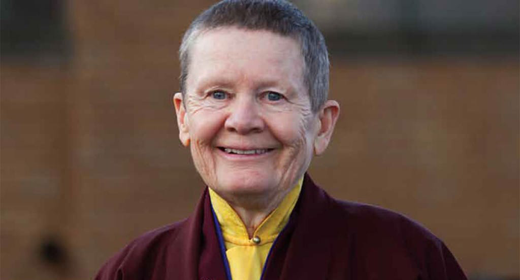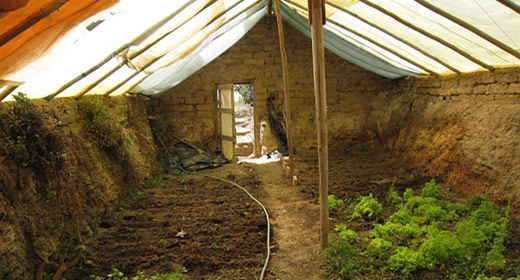Pema Chödrön: by Tami Simon: When many people are first introduced to tonglen, a Tibetan Buddhist practice for generating compassion, they find the technique—to breathe in pain and breathe out relief—to be counterintuitive. In this interview, Pema Chödrön explains.
 Pema Chödrön: Each of us has a “soft spot”: the place in our experience where we feel vulnerable and tender. This soft spot is inherent in appreciation and love, and it is equally inherent in pain.
Pema Chödrön: Each of us has a “soft spot”: the place in our experience where we feel vulnerable and tender. This soft spot is inherent in appreciation and love, and it is equally inherent in pain.
Often when we feel that soft spot, it’s quickly followed by a feeling of fear, and an involuntary, habitual tendency to close down. This is the tendency of all living things: to avoid pain and to cling to pleasure. In practice, however, covering up the soft spot means shutting down against our life experience. Then we tend to narrow down into a solid feeling of self against other.
One very powerful and effective way to work with this tendency to push away pain and hold on to pleasure is the practice of tonglen. In tonglen practice, when we see or feel suffering, we breathe in with the notion of completely feeling it, accepting it, and owning it.
Then we breathe out, radiating compassion, lovingkindness, freshness—anything that encourages relaxation and openness. So you’re training in softening, rather than tightening, your heart.
In this practice, it’s not uncommon to find yourself blocked, because you come face to face with your own fear, resistance, or whatever your personal “stuckness” happens to be at that moment. At that point, you can change the focus and do tonglen for yourself and for millions of others just like you who, at that very moment, are feeling exactly the same misery.
I particularly like to encourage tonglen “on the spot.” For example, you’re walking down the street and you see the pain of another human being. On-the-spot tonglen means that you don’t just rush by—you actually breathe in with the wish that this person could be free of suffering, and send them some kind of good heart or well-being. If seeing that other person’s pain brings up your fear or anger or confusion (which often happens), just start doing tonglen for yourself and all the other people who are stuck in the very same way.
You see, there really is no separation between you and everyone else. Tonglen practice begins to dissolve the illusion that each of us is alone with this personal suffering that no one else can understand.
Tami Simon: Many spiritual practices teach us to breathe in bright, healing light, and to breathe out our darkness and pain. Tonglen seems to contradict those teachings.
PC: So many of us start along the spiritual path because we are suffering. But you must realize that for real healing to occur, there must first be deep compassion for yourself, especially the parts of yourself you dislike or consider ugly.
Many people hope a spiritual practice will let them avoid what they are ashamed of. But when you hide something from yourself, you are going to project it onto your world. You continually find it in others and it becomes the source of prejudices and dogmatic views. On top of that, you feel bad about yourself, because you aren’t the loving, open-minded, “spiritual” person you’d like to be. So you close down.
This is why it is so important to develop genuine compassion for yourself first. For instance, you may aspire to practice tonglen for that irritating old person, but perhaps what comes up instead is anger or fear, something painful and hard. At that point, you start breathing in and fully feel your particular fear or pain. And then you breathe out a sense of relief, for yourself and the people all over the world who are feeling that exact same hurt or numbness in that very moment.
TS: Could tonglen practice be just another abstract response to the very real brutality and problems in the world? For example, maybe it would be better to feed the hungry than to do tonglen.
PC: Well, you can also feed them, you see. If you see a homeless person on the street, and they need food, housing, medical attention—if you can give that, do it. But at the same time, work with tonglen, because that is how you start dissolving the barrier between you and them.
This practice takes great courage. It has real impact. Tonglen dissolves your solid sense of “I’m the wise person, I’m going to help this poor, unfortunate loser.” When people are hurting, what they really need is someone who is fully there for them—not someone who is condescending or officious. The only way for you to be there for them is by facing your fear or anger, whatever feelings cause you to shut down.
So no, I’ll tell you, this is not abstract. It really is practical. Tonglen is a way for you to be with people who need you—beginning with yourself. In the end, that’s what we all need more than anything else: to be there for each other, in every kind of situation.
*** *** ***
Ani Pema Chödrön was born Deirdre Blomfield-Brown in New York City in 1936. She is one of the first American women to be ordained as a nun in the Tibetan Buddhist tradition. Pema is author of How to Meditate: A Practical Guide to Making Friends with Your Mind (Sounds True, May 2013).









































